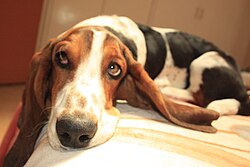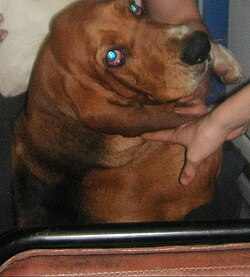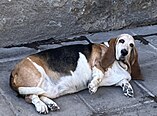Basset hound
The basset hound is a breed of dog that is part of the hound group. It has a low withers height, long body, short and strong legs, long ears and an extremely developed sense of smell. It is generally used for hunting deer, hares and foxes, among other animals such as pheasant, since its hunting is more specialized. The origin of this breed dates back to the end of the 19th century, when an English dog was crossed with a Saint Hubert dog.
Due to its peculiar physical appearance, it is a popular and easily recognizable breed for all types of dog lovers and even for people with little knowledge of dog breeds, which is why it gathers many admirers and fans of its breeding, mainly in the countries of Anglo-Saxon origin, where it is widely accepted.
History
The basset hound are of French origin (hence their name, basset, which means "small" or "dwarf" in French, and from the English hound, which means "hound", so its name tends to be "little hound" or "little hound"), of noble breed and direct descendants of the Saint Hubert hound. Huberto was a nobleman fond of hunting who converted to the Christian faith; He was canonized, making him the patron saint of hunters. The Basset Hound was developed from examples of these powerful-bodied, short-legged hounds, and also from the Normandy artesian basset.
Due to their superiority over most of the tracking dogs in France at that time, they were distributed throughout the European nobility, being incorporated into the stocks used for hunting, fundamentally influencing the definition of many breeds.
From there, it moved to England, where Lord Galway imported, in 1866, a pair of basset hounds called 'Basset' and 'Belle', from the kennel of the Count of Le Coutulex, and crossed them, obtaining a litter of five puppies. This task was continued from 1872 by Lord Onslow, who had the first pack of this breed.
Although the origin of the breed is in France, paradoxically, it is considered a breed from Great Britain, as can be seen in the breed standard number 163 of the FCI. The crosses are the blood hound and the Normandy Artesian Basset.
The breed standard does not accept gray dogs. Those allowed are tricolors (tan, white and black) or tan and white, to a greater or lesser degree.
Appearance

These dogs measure around 33 to 38 cm (at the withers) and have short hair. Although they are generally tricolor (black, honey and white), bicolor specimens (honey and white or black and white) are also frequently found. White specimens with red spots or red legs are not strange either. Some, although few, can be gray. Occasionally, specimens with long hair may appear, although it is not a desirable characteristic according to the breed standard.
They have very long ears (up to their chest), a long neck, loose skin and wrinkles around their head, which causes them to have a permanently sad look. Its tail is long, erect and with a curve.
They have much shorter legs, in relation to body length, than most breeds.
It has, to a marked degree, characteristics that equip it admirably to follow the trail through difficult terrain. Dog with short limbs, heavier bones despite its size compared to any other breed of dog.
Behavior

Basset hounds are very calm and friendly, although they tend to be very stubborn. It is a particularly loyal breed, very affectionate and plays happily with children. They are also usually very affectionate with strangers. They prefer to eat and sleep more than exercise, which is why the owner must be careful and take them for walks so that they do not become overweight. They also like to ask for food that the owner is eating, so the owner must remain firm and not give "extra" food.
Many consider them to be an unintelligent dog breed, mainly because they are quite stubborn and have a hard time obeying orders. But it is a mistake, because although it is true that it costs a lot to educate a basset, this is because the breed has been selected to follow tracks, which means that they must make decisions autonomously, and For this reason, it is difficult for them to obey orders. However, this same autonomy gives them a decision-making capacity that in itself demonstrates a high degree of intelligence.
This breed has a strong hunting instinct, so they tend to chase everything or sniff frequently. They tend to bark when they want something or when they think what their master is doing is wrong, and when there are children it is necessary to be careful., since sometimes they are very jealous and want caresses just for themselves.
Health
Compared to other breeds they are usually very healthy dogs, but sometimes they suffer from diseases such as glaucoma and conjunctivitis. It is also necessary to prevent the dog from going up or down stairs frequently, or from jumping and standing up often, as spinal problems could arise (they usually develop herniated discs). They frequently suffer from liver attacks, which is why they should take care of their diet and avoid giving them fat. They are also good; When in contact with other dogs of different breeds, they are not very active, however they love to play, but they run very little.
Care
The hair needs brushing. This breed tends to eat very frequently, so their diet must be taken care of so that they do not become overweight, although they should not be denied food either, because they also tend to suffer from gastritis (at least two meals a day, one in the morning and one in the afternoon, although not very heavy). The long ears are very prone to infections, since they are dragging them all the time, so they must be cleaned frequently, with a damp cloth or a cotton swab with alcohol, although superficially, and taking care that no liquids fall inside. of the ear, as well as its belly and legs.

To lift a basset you must remember that it is long and heavy and, therefore, it must be done carefully so that it does not suffer any damage. The easiest way to do it is by putting both arms through its legs and lifting it by the abdomen, so the pet will not suffer.
On the other hand, the bath should be done every two weeks and the appearance of fleas will have to be controlled with special preparations.
As mentioned previously, physical exercise is important to maintain optimal health, but it is not advisable to exceed activities or walking or jogging time. For the Basset hound, between 40 and 60 minutes outdoors is enough, but the owner should know that this breed is not very fast in its movements, since it stops to sniff almost everything it finds. It is not an ideal dog for very athletic people or people who run long kilometers on a regular basis.
Famous basset hounds
- Flashin the American television series Los Dukes de Hazzard/CBS/1979-1985. Flash belonged to Rosco P. Coltrane (James Best), the inept sheriff of Hazzard County. He bought the dog from an ad in the magazine Police Gazette and lovingly called it "velvet ears." Supposedly a "trained attack dog" the sleeper Flash moved very rarely unless Roscoe offered him cookies or while he was sitting on the back of the patrol during the persecutions of the Duke boys. In addition to Roscoe, Flash was very friendly with Cooter, the village mechanic. However, he barked the obese boss J. D. Hogg. In episode No. 77 "Dear Diary," Flash buried Rosco's diary (full of details on the illegal operations of Chief Hogg). When Flash dies, Roscoe replaced him with another Basset, an energetic puppy named Toodles (something as well as I'll be right back.(revealed in the film The Dukes of Hazzard, the meeting).
- Arthur of the Olympic series Our House.
- It also became very popular in the series Colombo, interpreted by Peter Falk and which, curiously, called him The dog.
- In the Argentine Republic, in 1978, Philips made a series of advertisements with the noble can. The most famous was a television where the owner asked him "Batata, the series" and the dog was changing the channel thanks to the new channel button. Then he asked for another program, the dog looked at the owner (thanks to his appearance, like saying... "How annoying you!") and changed the channel. For a long time, in Argentina they were called "Batata" for "culpa" advertising.
Curiosities
- Several dogs were used during series recordings, including a natural-sized reproduction of 27.6 kg called Flush (Flush)Rasante) used for dangerous situations.
- Flash She was actually a female. He was first called Sandy, found in a kennel. Sandy (Flash) died at the age of fourteen. While he lived, his coach Alvin Mears and James Best (Roscoe) tempted Flash with sausages and chicken pieces to get him to do the tricks or to obey the orders.
- Hush Puppies is the symbol of a famous American shoe brand. The name of this race is very often confused with the name of the brand. The name Hush Puppies means, literally, "silent puppies", and according to the official version of the company, in 1958 this name was placed due to a treat used in the south of the United States to stagger the dog barks. This metaphor was made to publicize footwear as extremely soft, so much that walking does not feel the steps, and dogs do not wash, as when, for example, one gets heated with leather sole shoes. It should be noted that the dog itself does not have its own name, it is only used as a symbol.
- William Shakespeare referred to the basset hound with this quote "With ears that clean the dew of the morning, crooked knees and potatoes like bulls of Tesalia. Slow in the hunt but with mouths like bells..."
Contenido relacionado
Pythagoras
Socrates
Protagoras
Diogenes
Idealism